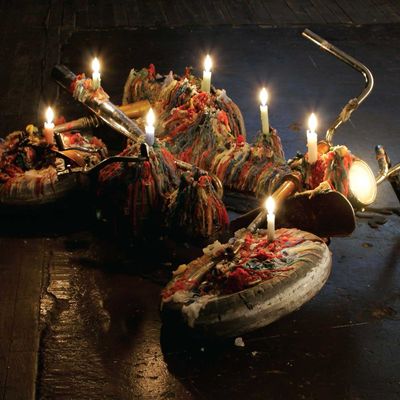
The Rubell Family Collection celebrated its 20th anniversary last month, in a former DEA warehouse adjacent to MiamiÔÇÖs Wynwood neighborhood. It was also the 50th anniversary of the Rubells themselves, Donald and Mera, who have been collecting (and bickering insightfully about it) throughout their marriage. To celebrate, the Rubells staged an exhibition, ÔÇ£To Have and To Hold,ÔÇØ which opened during Art Basel Miami Beach and gave a retrospective look at their collection and how itÔÇÖs been built over the years: The couple tends to find an artist early, get to know them, and then support them like surrogate genius-children ÔÇö Jean-Michel Basquiat, Keith Haring, among many others. Often they buy a large body of their work at this unknown stage of their career on the installment plan.
In addition to the show, they also published a book, which includes a number of testimonials, written by those now-accomplished and well-known artists, about how they came to join the family. Here are a few of them, along with images of the first artwork by each that the Rubells bought.
Mark Handforth (above)
The candles are a way of keeping the static sculpture alive, of not giving in to the monument but somehow maintaining the creative process; of keeping it all fluid, rolling, open. By handing over the essential creative gesture ÔÇö whoever places the candles really makes the piece ÔÇö I hoped to throw it open; there is no particular end and no particular destination. At the same time, by virtue of┬áthe meaning and function of those materials, the piece inevitably becomes a strange kind of monument; all that molten wax, all that┬áfluidity, hardens into the floor and locks the moment in time, locks the bike in place, buries it. The flames are very much alive; but strangely, the more life there is to the flame, the more dead the bike becomes.
Marlene Dumas
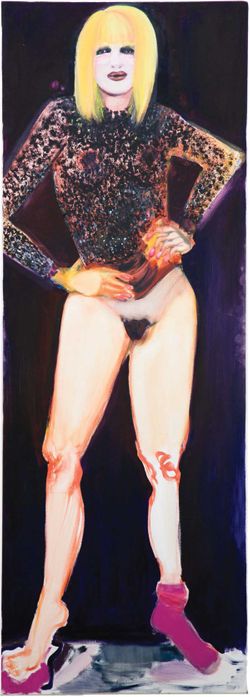
Miss January was conceived for a solo show of mine called ÔÇ£Miss World,ÔÇØ at Galerie Paul Andriesse in Amsterdam, in the year 1998. She started out as, or rather her source was, an airbrushed, ultra smooth-skinned, high-gloss centerfold photograph for the January number of a Dutch Playboy magazine (date unknown, but I suspect it was the late ÔÇÖ70s). A young, super healthy-looking blonde that combined eroticsm with winter sports. Naked, but for her zippedopen, short ski jacket and socks ÔÇö one foot without and one still with a bright-pink, woolen sock on. Not quite a female Santa Claus as Christmas was just over and the December issue had just passed. But her legs, they went on forever. (In the history of Western painting, we often find that it is more sexually arousing to be half-dressed or just partly exposed, than totally naked.) I was more fascinated than attracted to her. She looked like an Amazone and felt quite alien, even a bit scary to me.
Although I am a woman too, IÔÇÖm small and round and more next-to-you; this was a figure to look up to. At that stage of my life I had used many different types and poses of pin-ups, porno stars, fashion models, and beauty contestants in my work. She seemed to combine aspects of all of these forms of deliberate stagings of the sensuous female. But this was just the start, the inspiration to make this painting. When she became a painting, all kinds of things changed. She became even taller. So tall that when you stand in front of the work, your eye level is at the point where the dark triangle starts and the legs begin to leave the torso.
She also connects to my Magdalena group of females that was part modern catwalk, and part ancient mythical times. She ended up wearing a black ÔÇ£gesturalÔÇØ (painting for paintingÔÇÖs sake) elegant top suggesting a garment of lace. Strange to wear a sock with that, maybe? Who knows what she is about. Maybe itÔÇÖs the mixture of sugar and spice.
Robert Longo
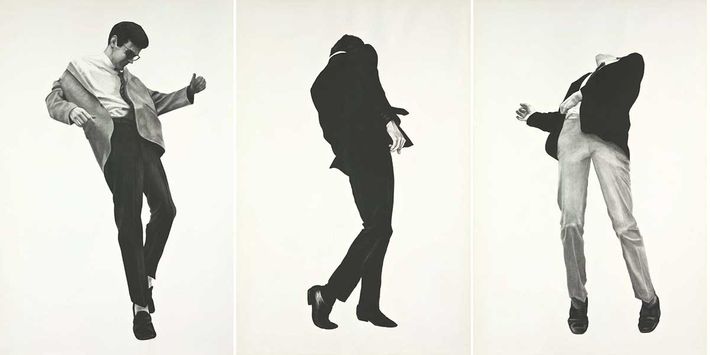
The title of this work, Men Trapped in Ice, comes from a dream I had of men with their feet frozen in ice. They could only move from the ankles up and squirmed and writhed in torment. This work was the second triptych that I made in the very early stages of my practice. I was soon to focus all my attention on the ÔÇ£Men in the CitiesÔÇØ series, so this was the first work that I created once I had figured out what my main investigation would be. It would set the tone for the explosion that became the ÔÇ£Men in the CitiesÔÇØ series, which included both men and women. I soon stopped playing in bands and doing performances in order to hunker down to this journey. What is significant about this seminal work is that the three drawings are all based on photographs I took of my friends ÔÇö not appropriated images. Two of the men are punk/no wave musicians. The clothes they have on were our uniforms, our ÔÇ£no waveÔÇØ urban uniforms. Men wore skinny ties, stovepipe pants, and women wore skirts and black dresses. It was stuff that we found at thrift shops. These figures are not the ÔÇ£yuppiesÔÇØ that they have been confused with recently. They are much more rock ÔÇÿnÔÇÖ roll, film noir, violent. The triptych is designed in an almost rhythmic pattern, like chord changes in a song. ItÔÇÖs less like Muybridge ÔÇö sequential ÔÇö and more about rotation. In that sense I think of them as abstract calligraphy, in a way. I think that informed me. I also love this dichotomy of are they dying or are they dancing? The duality became increasingly more interesting once I gained a grasp of what I was doing.
In creating these works, I would make plans and sketches almost like music notations, which I would follow to take the photographs that served as source images to the largescale drawings. In the beginning I was throwing everything at the models ÔÇö tennis balls, film canisters ÔÇö to get them to move in a spastic, psychotic manner. I wanted to capture the image of a gesture that existed between gestures; the split seconds. Some of the photographs I took during these shoots, I recently published as a series of photographs. In some of the photographs you can actually see the film canisters or tennis balls that I threw at them. Eventually the drawings in the ÔÇ£Men in the CitiesÔÇØ series became significantly larger ÔÇö as tall as 9 by 5 feet ÔÇö and I presented them in groups of three to ten drawings of men and women. When the Rubells bought this work it marked a crucial moment for me as a young artist; it gave me the vote of confidence that I was onto something important.
Cindy Sherman
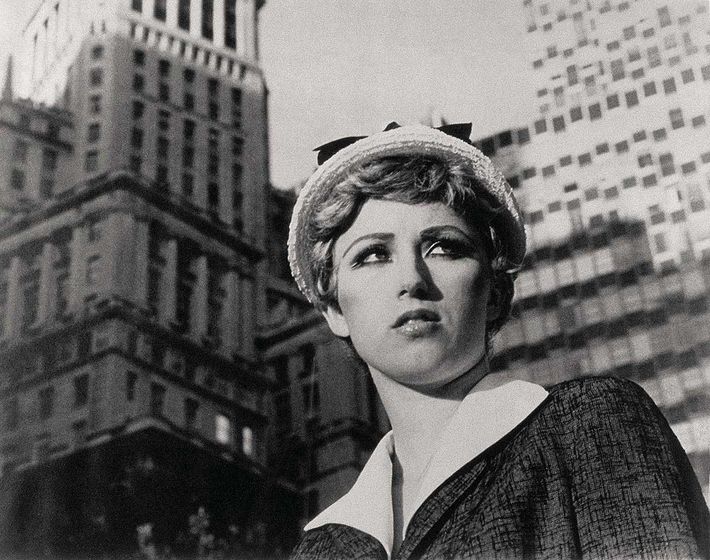
When I made this photo, IÔÇÖd already shot several of the other ÔÇ£Film┬áStillsÔÇØ images from that year and since I always worked where I lived, every nook and cranny of my loft had been pretty much utilized, so I was ready to head to real locations.
IÔÇÖd made lists of what kinds of backgrounds I thought I could find in the city. I forget if IÔÇÖd actually done any scouting ÔÇö itÔÇÖs possible. But the idea was that my boyfriend at the time, Robert Longo, would drive his van around downtown where we lived, and I would have costumes and makeup in the back and transform into characters once I spotted a good location, once I decided upon the character for that location.┬áWhich I guess also meant thinking about what would be happening there: is she an office worker coming out of a building,┬á or is it her first day on the job in a strange city, or is she running away from something, on her way to a mysterious assignation?
Of course, as always (even then) I wanted to leave it ambiguous.
So this was the character in the suit. We shot her way downtown, near Battery Park, I believe in front of the Customs House or nearby. IÔÇÖd give the camera to Robert and then tell him where to stand, guiding/directing him.
In those days, since I couldnÔÇÖt really afford the luxury of shooting a┬álot of film, I would just shoot maybe six to seven shots per character. As soon as I thought weÔÇÖd gotten enough, IÔÇÖd move onto the next character, so each contact sheet had about four or five different characters/locations on it.
Richard Prince
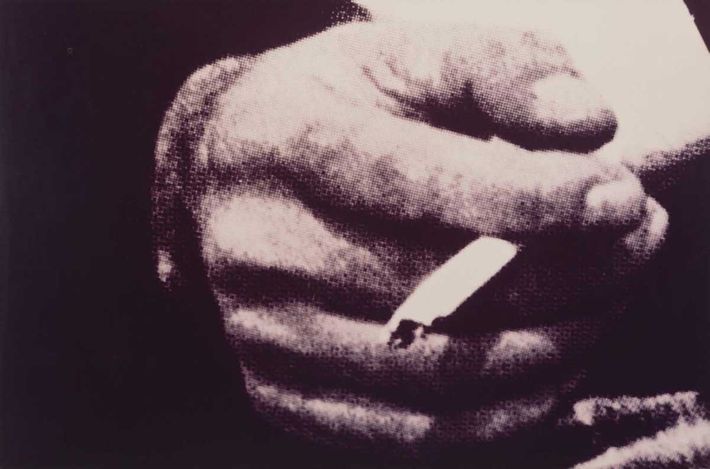
Most of all I remember the RubellsÔÇÖ parties after the Whitney biennials.┬á
And seeing all the art from my generation on their walls. They were the first to do anything like that. Early ÔÇÖ80s. Stuff that had been made only a couple of years before. Up-to-date doesnÔÇÖt begin to describe it. I donÔÇÖt know how they got there. But they did. And they did it together. That was another thing that stood out ÔÇö they were forward and fierce in their choices, but their decisions were tempered by four romantic eyes.
Anyway  it was the first time Id ever seen anything of mine hung on someone elses wall. Untitled, (mans hand with cigarette), 40 x 60, 1980. They got it. And in more ways than one. It was in their living room and there were tons of people shouting at each other. It was loud. The place was packed. You could hardly move. Good times. Drinking and smoking. (There were plenty of hands with cigarettes.)
I was still an outsider but that evening I felt, if only for a moment, part of another family.
One other thing 
It was the first time IÔÇÖd seen or met Robert Mapplethorpe.
He was decked out.
Motorcycle gear.
Leather jacket and fucking chaps!
He didnÔÇÖt say a word. He just looked and looked, and he looked.
I looked, too.
I couldnÔÇÖt help it.
This was like the second biennial party. Around 1985? ÔÇÿ86?
IÔÇÖd just done my first Untitled (Girlfriend).
Seeing Robert that night made think  maybe I should go back to the drawing board 
I did.
I started drawing cartoons and jokes.
Don and Mera bought those too.
Elad Lassry
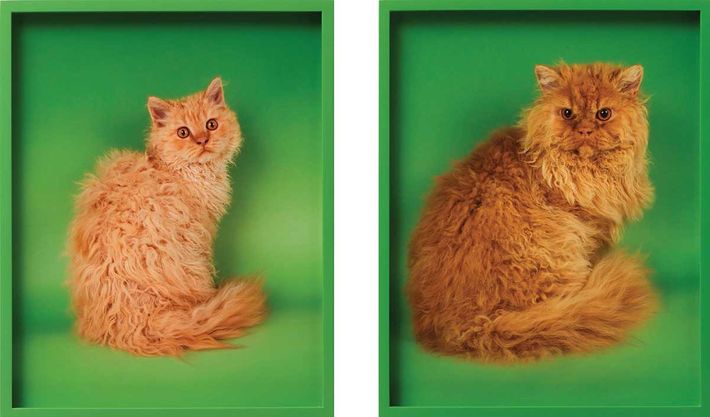
Two cats, some say they are funny. Both have red hair, both look back at the camera. Are they part of a larger family? What is the difference from one cat and another? Looking into that seems to bring few answers. Is the cat more of a subject or an object? If a subject, then to what extent? Perhaps these two are exchangeable. Cats, science models. Both move uncontrollably in the studio. Both difficult to photograph.
What does it mean when something is difficult to photograph?
The lens is useless without a nervous system.
George Condo
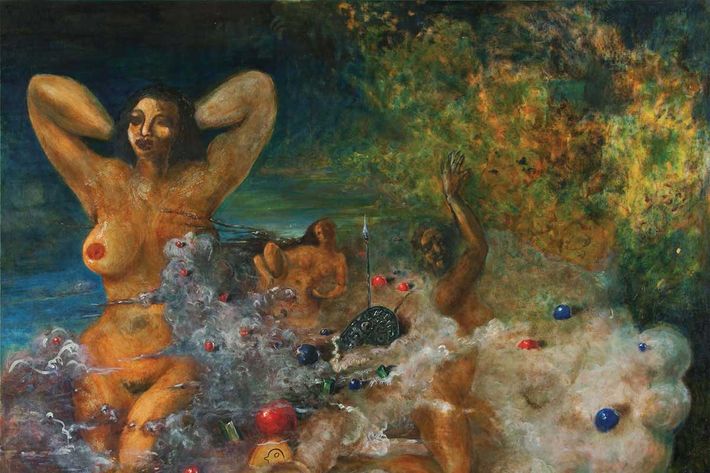
At that particular time in life [1984], as Dr. Don Rubell would know firsthand, I was not taking very good care of myself. Living in the East Village on 10th Street between First and Avenue A right next to the old Turkish bathhouse. I never even made it in once. In fact, as Don also knows, I never even plugged in my refrigerator. Long nights out in the cold with buddies Keith Haring, Rammellzee, artists from the Lower East Side, Basquiat, and various other well-known self-abusers lent themselves to what I called and memorialized as The Evening of Destruction. This painting was a kind of metaphoric composition employing all the pseudo-classical elements that I was exploring after my first time in Paris and a trip to the Louvre. I was thinking of coming back to the city with my version of DelacroixÔÇÖs The Death of Sardanapalus. A kind of bedroom in the clouds, an imaginary outdoor celestial brothel with sirens and alluring female figures representing torture, self-indulgence, misery, and ecstasy all at once, as it seemed life was like at that time. There was no actual narrative like in the ÔÇ£realÔÇØ romantic classicism it was based on. ThatÔÇÖs probably why I called them ÔÇ£fake Old Masters,ÔÇØ because there was no text or symbolic meaning in any of it. There were symbols that meant essentially nothing. In fact it was this connection I wanted to make, ironically with Malevich, in that it is what it is and nothing more. Or Frank StellaÔÇÖs famous statement, ÔÇ£it is what you see,ÔÇØ but in my own way ÔÇö ÔÇ£it is a picture of our collective memories of classicism without the subject, academic perfection, or content.ÔÇØ For me it was the largest painting IÔÇÖd made to date and I wanted to work it up to a finishing point to open my first one-man, double-exhibition at Pat HearnÔÇÖs new gallery on the Lower East Side and Barbara GladstoneÔÇÖs in Soho. I wanted to prove something about the rebirth of painting, that it was not dead and in fact it was more alive than ever. Yet none of the academic perfection was necessary in order to evoke the ÔÇ£memoryÔÇØ of those rules and regulations in art. Like a punk-rock version of Mozart. In my case I thought about ÔÇ£conceptual representation,ÔÇØ a contradictory paradigm that would be a picture of a painting that seems to have existed in the history of art, yet never has.
Francesco Clemente
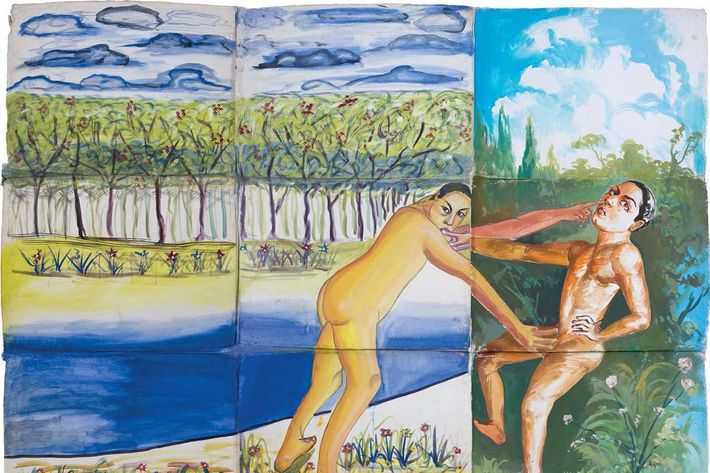
In the ÔÇÖ70s the Rubells visited my studio in Rome. In the ÔÇÖ80s they returned to my studio, which was by then in New York. Don said, ÔÇ£When we met you had no furniture and you slept on the floor. Now you have no furniture and you sleep on the floor, but I notice that you have a TV!ÔÇØ The TV didnÔÇÖt last, but I did sleep on the floor a few more years. Two of the three large works in the Rubell Collection were made in the studios of the sign painters of India who, at that time, painted huge murals advertising Bollywood films. Through the collaborative nature of these works, I wanted to challenge the boundaries of the self and do away with any signature style or signature process. My life and work had to be nomadic and always in a state of flux, to witness and to mimic the fragmentation of the self. The paintings were on sheets of handmade paper, bound together, so that I could carry them by hand on the plane, cheaply and safely, in a pre-global planet. I was chasing an alternative narrative of modernity. I didnÔÇÖt ÔÇö I donÔÇÖt ÔÇö believe in progress, in formal solutions. I thought that art was the medium of the present tense, and the present was where one could embrace the experience of the great spiritual traditions without being bound to any.



